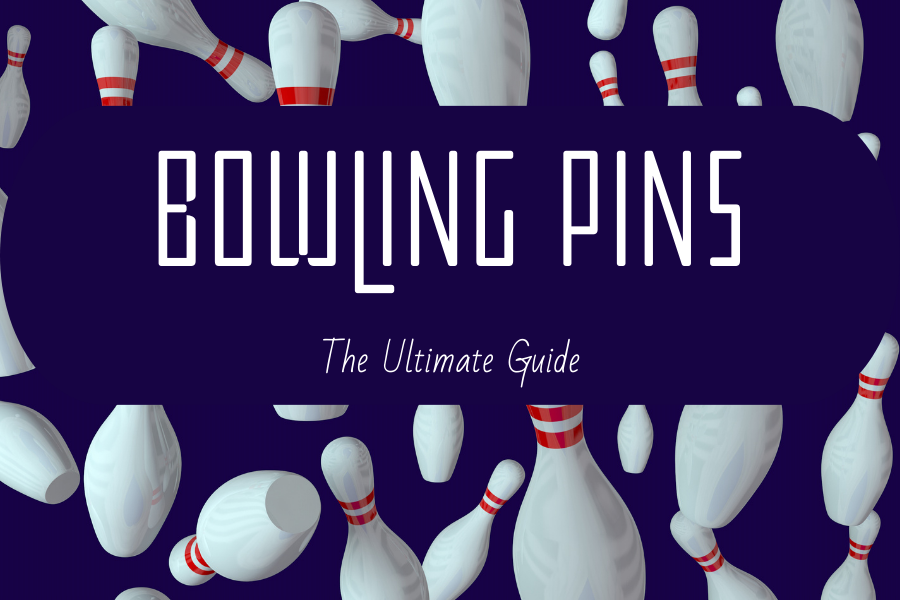
Introduction
Welcome to our comprehensive guide on bowling pins, the unsung heroes of one of the world’s most popular sports. Whether you’re an aspiring bowler looking to understand this essential piece of equipment better, or a seasoned player aiming for that perfect game, understanding bowling pins can elevate your experience.
They might seem simple at first glance but delve deeper and you’ll find there’s more than meets the eye – from their construction and evolution to their various purposes in different types of games.
Key Takeaways
- Bowling pins serve as both the aim and score-marker in bowling games, and their dimensions and weight are carefully regulated by organizations like the United States Bowling Congress (USBC).
- There are different types of bowling pins, including tenpins, duckpins, fivepins, candlepins, and kegels. Each type has its own unique characteristics that can affect gameplay.
- The construction of bowling pins involves shaping blocks of rock maple wood or using synthetic materials. Strict specifications ensure uniformity across all pins used in competitive play worldwide.
- Over the years, bowling pin design has evolved from vintage wooden styles to modern designs made with advanced technology and synthetic materials for improved durability and consistency. These changes have set new standards in performance on the lanes.
Understanding Bowling Pins
Bowling pins are the main targets in bowling games, serving as the objects that bowlers aim to knock down with their bowling balls.
Definition And Purpose Of A Bowling Pin
In the sport of bowling, a pin serves as both an aim and score-marker. The main objective is to knock down these pins using a bowling ball in one turn or ‘frame.’ With their distinctive cylindrical shape that tapers at both ends, they are uniquely designed to offer challenge and excitement for bowlers.
Ten-pin bowling pins, for instance, stand 15 inches tall with a width of 4.75 inches at their widest point and weigh around 3 pounds and 8 ounces as set by the specifications of United States Bowling Congress (USBC).
Whether you’re playing tenpins, five-pins, duckpins or candlepins; each type provides varying levels of difficulty due to differences in size, shape, weight plus the number used per frame.
The Different Types Of Bowling Pins
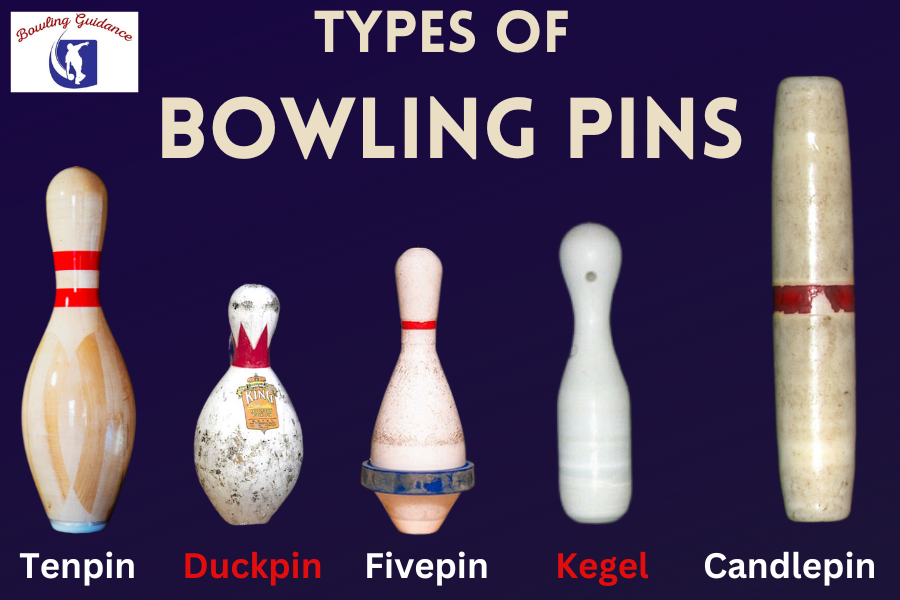
There are several different types of bowling pins, including tenpins, duckpins, fivepins, and candlepins. The number of bowling pins used varies with the type of bowling.
Tenpins
In the realm of bowling, Tenpins reign supreme, being recognized globally as a classic icon of the game. A standard tenpin measures 15 inches tall and is approximately 4.75 inches wide at its widest point.
The bowling pin weighs in at around 3 pounds and 8 ounces ±2 ounces.
The construction process and specifications for each pin are meticulously regulated by the United States Bowling Congress (USBC), thus ensuring consistent size and performance across every game played worldwide.
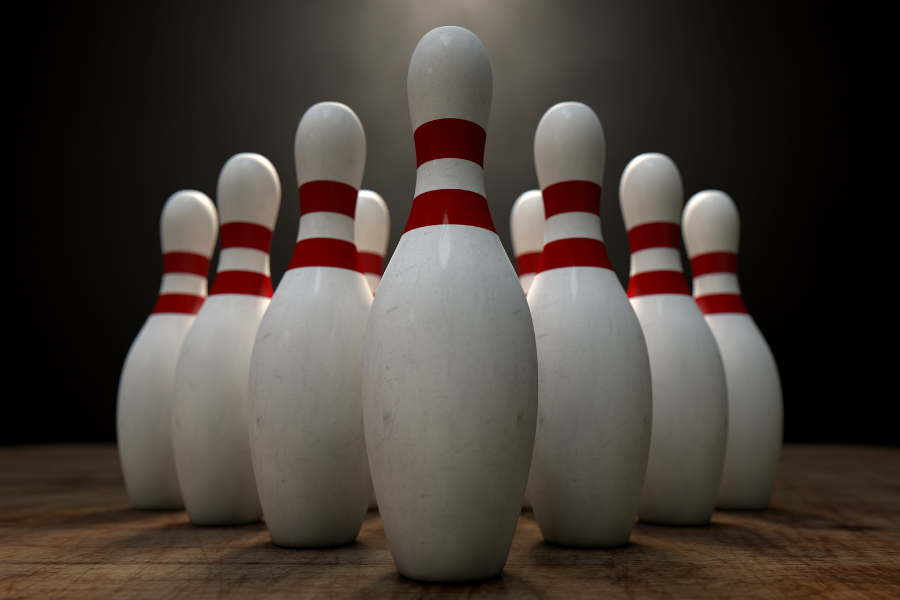
When purchasing your set of Tenpins, it’s crucial to consider not just their manufacturing quality but also their life span under rigorous gameplay conditions – all with adherence to established USBC parameters for maximum fairness in tournaments or casual rounds alike!
Duckpins And Fivepins
Duckpins and fivepins serve as fascinating variants in the world of bowling, offering a unique spin on pin design and gameplay. Duckpins fall shorter and squatter than your standard tenpin counterparts, standing at only 9.4 inches tall with a weight limit between 3 pounds 6 ounces to 3 pounds 12 ounces.

Venturing up north, you’ll encounter Canadian fivepins; perfectly positioned size-wise halfway between duckpins and tenpins. What sets them apart is their distinct inch-wide rubber band around the widest part of the pin which provides a distinctive bounce unpredictability during play – keeping players alert and constantly strategizing.
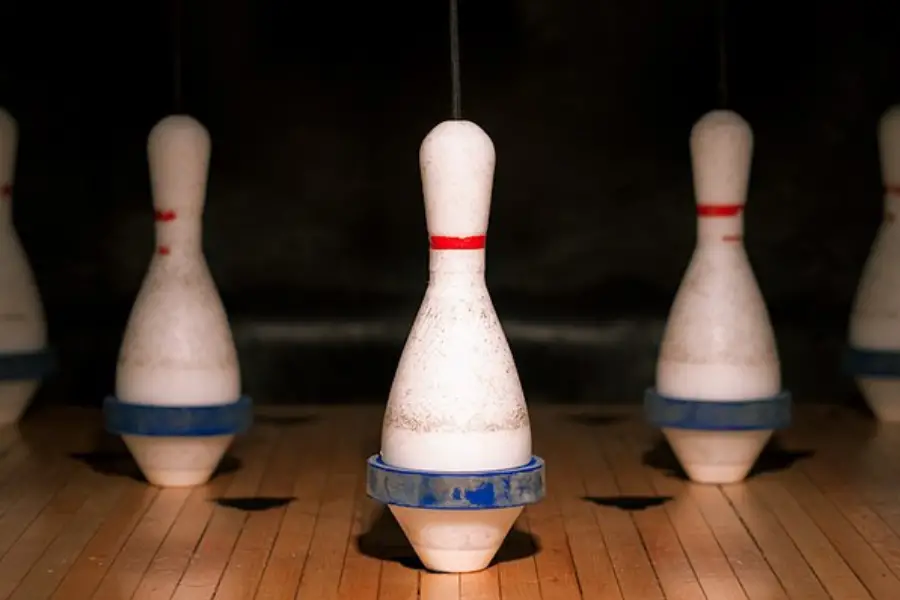
Candlepins
Candlepins are a unique type of bowling pin, distinct in their appearance and size. Standing as the tallest among all bowling pins, candlepins measure an impressive 15+3⁄4 inches in height and weigh around 2 pounds 8 ounces.

These slim and slender pins add an exciting twist to the game, challenging bowlers with their narrower target area.
Unlike traditional tenpin or duckpin bowling, which use larger and wider pins, candlepins require precision and accuracy in aiming for their thin bodies.
While they may not be as widely known or played as other forms of bowling, candlepin bowling has its own dedicated fan base in certain regions.
So if you’re looking to try something different in the world of bowling, give candlepins a shot! With their distinctive shape and thrilling gameplay dynamics, you’re sure to enjoy the challenge they bring to your next bowling session.
Kegels
Kegels, although not as widely known as other types of bowling pins, hold their own significance in the world of bowling. Originating from Germany, kegels are shorter and more stout compared to traditional tenpins.

They were primarily used in nine-pin bowling before the game evolved into ten-pin bowling.
One interesting fact about kegels is that they are often associated with European-style or “skittle” games such as German Kegeln and Austrian Bowling. These games differ from conventional American tenpin bowling in terms of scoring and pin arrangements.
Although less common than tenpins or candlepins, some bowlers do seek out kegel-specific competitions or use them for practice drills due to their different characteristics.
The Construction Of Bowling Pins
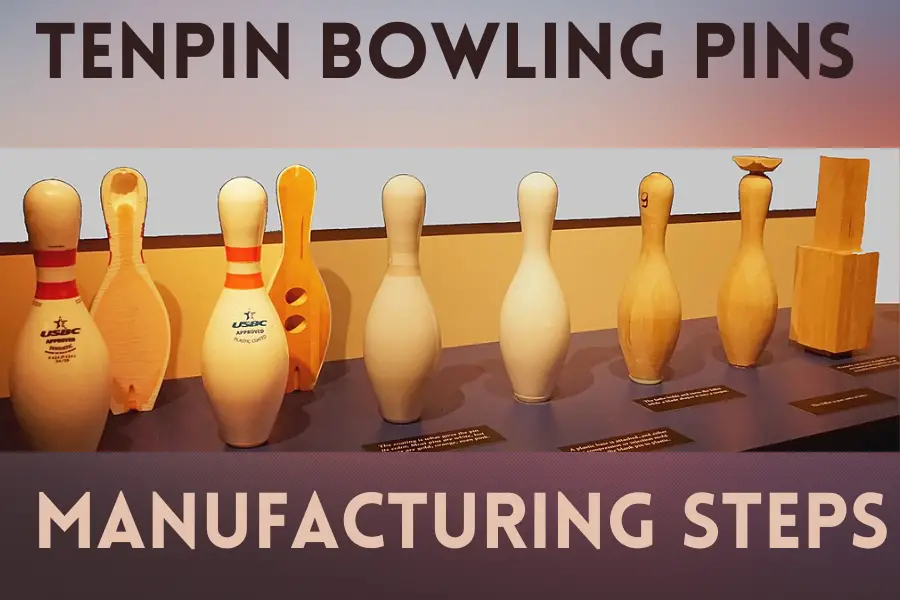
Bowling pins may seem simple, but their construction involves a precise and detailed process. Bowling pins are typically made from blocks of rock maple wood that are glued together and shaped on a lathe.
Once shaped, the pins undergo further treatment to enhance their durability and appearance. They are coated with a plastic material, painted with vibrant colors, and finished with a glossy surface.
In addition to traditional wooden construction, synthetic bowling pins have become increasingly popular in recent years. These synthetic pins are made from approved materials that meet specific standards set by organizations like the United States Bowling Congress (USBC).
Whether made from wood or synthetics, bowling pin manufacturers adhere to strict specifications established by governing bodies like USBC and International Bowling Federation (IBF) aka World Bowling.
Understanding how bowling pins are constructed helps bowlers appreciate their quality and craftsmanship. The combination of sturdy wooden cores and protective coatings ensures that these essential pieces of equipment can withstand countless strikes while maintaining their integrity on the lanes.
The Evolution Of Bowling Pins
Bowling pins have undergone significant changes in design and construction throughout history, transitioning from vintage wooden pins to modern synthetic ones, resulting in improved durability and consistency.
Vintage To Modern Design Changes
Over the years, bowling pins have undergone significant design changes, transforming from vintage styles to modern designs. The evolution in design has not only enhanced the appearance of the pins but also improved their performance on the lanes.
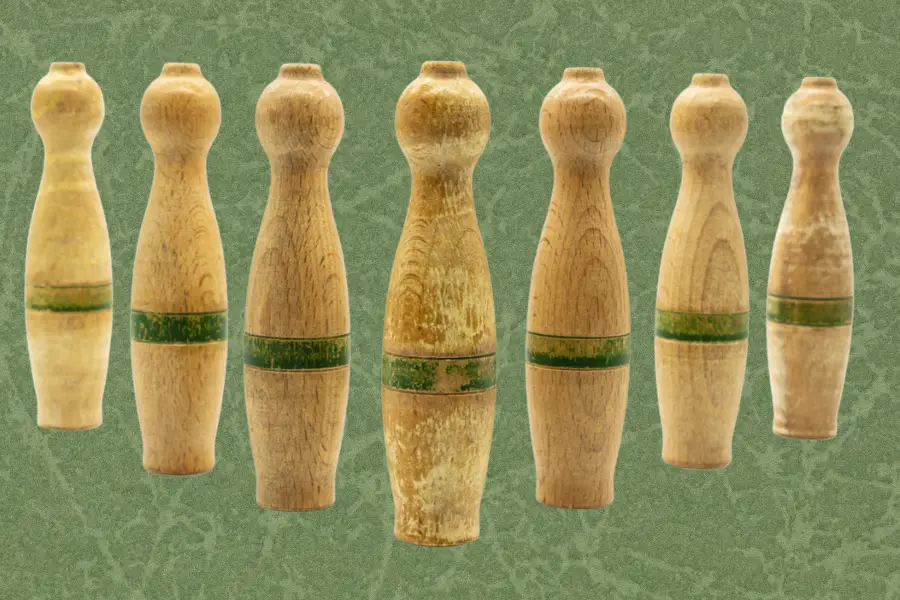
One notable change is the shift from wood to synthetic materials for pin construction.
Another important aspect of modern pin design is the incorporation of advanced technology to ensure durability and consistency. Manufacturers like AMF and Brunswick have introduced plastic-coated bowling pins that can withstand constant use without losing their shape or integrity.
Bowling organizations like the United States Bowling Congress (USBC) play a crucial role in setting standards for pin specifications across different types of bowling games.
Their guidelines ensure that all bowlers can enjoy fair competition regardless of whether they are playing in local leagues or prestigious tournaments.
The type of pinsetters for bowling pins has also caused changes in the design of the pins. Traditional pinsetters are complicated machines, with many moving parts. Bowling Pins on strings are becoming more common as string pinsetters gain in popularity. This type of pinsetter requires that the bowling pins be fitted with nylon strings that rise from the their tops.
In conclusion, vintage to modern design changes in bowling pins have revolutionized the game by improving overall performance and consistency. From traditional wooden constructions to durable synthetics coated with advanced plastics, these contemporary designs have set new standards in terms of durability and accuracy on the lanes.
How To Choose Bowling Pins
When choosing bowling pins, consider factors such as weight, material (rock maple wood or synthetic), and whether they are USBC approved.
Considerations For Purchasing
When purchasing bowling pins, there are several factors to keep in mind. These considerations will ensure that you choose the right pins for your game:
- Size: Bowling pins come in various sizes depending on the type of game you play. Make sure to select pins that meet the specifications of your preferred bowling style, whether it’s tenpins, duckpins, or candlepins.
- Weight: The weight of bowling pins can vary slightly within the specified range. Consider how the weight of the pins will affect your gameplay and choose accordingly.
- Construction: Most bowling pins are made from rock maple wood, but synthetic options are also available. Decide which material suits your preferences and playing conditions best.
- Durability: Look for bowling pins that are built to withstand repeated impacts from bowling balls. Check customer reviews and ratings to determine the durability of different brands and models.
- Official Certification: If you plan on participating in official league games or tournaments, ensure that the bowling pins you purchase are USBC approved or meet the standards set by relevant governing bodies like World Bowling.
- Brand Reputation: Choose well-known brands like AMF, Brunswick, or Champion known for manufacturing high-quality bowling equipment.
- Budget: Determine your budget before shopping for bowling pins and look for options within that price range. Consider buying used or refurbished pins if you’re on a limited budget.
- Additional Accessories: Some sellers offer bundled packages with additional accessories like pinsetters, scoring tables, or even vintage collectible items. Assess whether these add-ons align with your needs and interests.
By considering these factors when purchasing bowling pins, you’ll be able to make an informed decision based on your specific requirements and preferences while ensuring a great gaming experience every time.
If you looking for bowling pins for sale so that use in your home, review this article to learn about some excellent options.
The Role Of Bowling Pins In The Game
Bowling pins play a crucial role in the game, as they serve as the target for bowlers to knock down with their bowling balls. Once the ball is rolled, and pins are knocked down, the bowling pinsetter sends the score to the bowler’s scoring terminal, resets the pin positions, and returns the ball for the bowler’s next throw.
Scoring And Pin Placement
Scoring and pin placement are crucial aspects of the game of bowling. As a bowler, it is important to understand how scoring works and how the pins are strategically placed on the bowling lane. Here are some key points to keep in mind:
Scoring:
- Each pin knocked down by a bowler’s ball counts as one point.
- If all ten pins are knocked down with the first ball, it is called a strike and awarded ten points plus additional bonus points for subsequent balls thrown in that frame.
- If all ten pins are knocked down with two balls, it is called a spare and awarded ten points plus additional bonus points for the next ball thrown.
- An open frame occurs when fewer than ten pins are knocked down in two balls, and the player receives one point per pin.
Pin Placement:
- The pins are set up in an equilateral triangle formation at the end of the bowling lane. The bowling pins are numbered, 1 to 10.
- The distance between the bowling pins is determined and fixed by the bowling pinsetter. How far apart the bowling pins are is a specification established by USBC.
- The headpin (or 1-pin) is positioned directly in front, followed by two pins behind it forming an upside-down “V” shape.
- The remaining seven pins fill out the triangle formation behind these three front pins.
Aim for Strikes:
- Use proper technique to hold and release the ball
- A strike is when you knock out all the bowling pins with your first ball. To achieve a strike, aim to hit the pocket area between the 1 – pin (headpin) and either of the two adjacent pins (known as pocket hits).
- A pocket hit maximizes pin carry and increases your chances of knocking down all ten pins with one ball.
Spare Conversions:
- When facing remaining pin combinations after your first ball, strategize to convert spares by targeting specific remaining pins.
- For example, if you leave a single pin standing after your first throw, aim for that particular pin on your spare attempt. That way, you can knock down ten bowling pins in two tries.
Adjustments:
- As lanes transition during play due to oil breakdown or changing conditions, adjust your target and delivery accordingly.
- Pay attention to how your ball reacts to the lane surface and make necessary modifications to ensure consistent pin placement.
Understanding scoring and pin placement is essential for improving your bowling game. By being mindful of these factors, you can better strategize your shots, aim for strikes and spares, and ultimately increase your overall score. Keep practicing and honing your skills to become a more successful bowler.
Bowling Pins Video
This outstanding video shows the entire process of the creation of bowling pins!
Conclusion
In conclusion, understanding the world of bowling pins is crucial for any bowler looking to improve their game.
Bowling pins have come a long way since their early days, with various organizations like USBC and World Bowling setting standards and regulations.
Whether you’re playing tenpin, duckpins, or candlepins, each type of pin has its own unique characteristics that can affect your strategy on the lanes.
As technology continues to advance in the bowling industry, so too will the design and performance of bowling pins.
So next time you step into your local bowling center or compete in a tournament, take a moment to appreciate these unsung heroes—the bowling pins—who play such an integral role in one of America’s favorite pastimes.
FAQ’s
Bowling pins are typically made of a combination of wood and plastic. The core is usually made of hard maple or another durable wood, while the outer shell is constructed from a tough plastic material.
Traditional ten-pin bowling pins have a height of approximately 15 inches (38 cm) and weigh around 3 pounds 6 ounces (1.5 kg). However, there may be slight variations in size and weight depending on the specific type of bowling being played.
In traditional ten-pin bowling, players aim to knock down all ten pins that are set up in a triangular formation at the end of each lane. A standard game consists of ten frames, with two opportunities to knock down all the pins per frame for a maximum score of 300 points.
Yes, it is possible to purchase your own set of bowling pins for personal use or for recreational purposes at home or in other non-commercial settings. These sets often include smaller-sized lightweight plastic pins that can be easily knocked down by children or individuals with limited strength.

